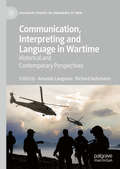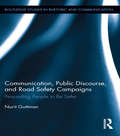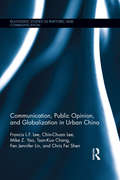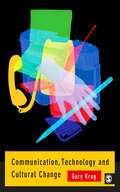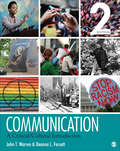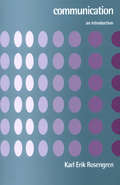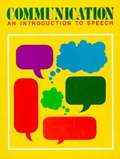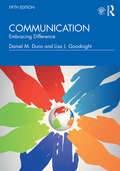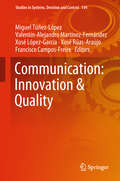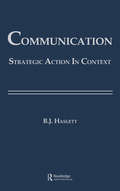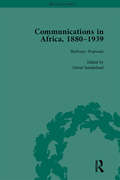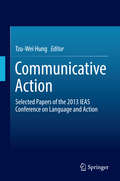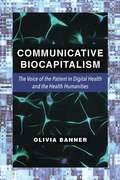- Table View
- List View
Communication, Culture and Ecology: Rethinking Sustainable Development in Asia (Communication, Culture and Change in Asia #6)
by Kiran PrasadThis book offers comprehensive insights into the cultural and ecological values that influence sustainable development across Asia, addressing the cultural, religious and philosophical moorings of development through participatory and grassroots communication approaches. It presents a range of contributions and case studies from leading experts in Asia to highlight the debates on environmental communication and sustainable development that are relevant today, and to provide an overview of the positive traditions of ecological sensitivity and cultural communication that may find common ground between communities. This well-researched guide to the dynamic and complex terrain of communication for sustainable development offers uniquely practical perspectives on communication, environment and sustainable development that are of immense value for policy makers, media scholars, development practitioners, researchers and students of communication and media studies.
Communication, Entertainment, and Messages of Social Justice
by Richard West Christina S. BeckThis edited collection explores the contemporary interplay among three pivotal areas found in cultures around the world: communication, entertainment, and messages of social justice. Each chapter centralizes communication as instrumental in creating mediated messages pertaining to social justice, usually resulting in a more educated audience.Using an accessible writing style, the contributors investigate both classic and contemporary social media, television, film, stage, radio, and podcast productions by employing both qualitative and quantitative methods. Furthermore, through case studies on topics including transphobia, indigenous comedy and drag performance, this book assesses key issues and themes portrayed in contemporary entertainment education. It provides a foundational framework for analysis by utilizing a broad range of theoretical models to explore representations of race, class, gender, advocacy, and pedagogy among others as well as their communication implications.This book will be of interest to scholars and students in the fields of Communication Studies, Popular Culture Studies, Media Studies, Theatre Studies, Social Justice Studies, Sociology, and Psychology.
Communication, Interpreting and Language in Wartime: Historical and Contemporary Perspectives (Palgrave Studies in Languages at War)
by Richard Gehrmann Amanda LaugesenThis edited book provides a multi-disciplinary approach to the topics of translation and cross-cultural communication in times of war and conflict. It examines the historical and contemporary experiences of interpreters in war and in war crimes trials, as well as considering policy issues in communication difficulties in war-related contexts. The range of perspectives incorporated in this volume will appeal to scholars, practitioners and policy-makers, particularly in the fields of translating and interpreting, conflict and war studies, and military history.
Communication, Meaning and Misconceptions: How to Help, Heal and Hurt with Language
by Karol JanickiThis book covers several related topics anchored in the idea of how meaning is created. The central focus in the book is, however, on how language awareness may help us communicate smoothly and solve social problems. The book takes up language misconceptions and their social significance, and promotes the view that regarding meaning (and language in general) as open and flexible, rather than closed and rigid, may lead to critical thinking, innovation, and creativity. The book covers topics such as words and things, words and emotions, fake news and hate speech, and it has been written in the form of short informal dialogues to engage readers and make linguistic concepts accessible.
Communication, Public Discourse, and Road Safety Campaigns: Persuading People to Be Safer (Routledge Studies in Rhetoric and Communication)
by Nurit GuttmanThis book discusses the use of communication campaigns to promote road safety, arguing that they need to elicit public discourse on issues pertaining to culture, equity, gender, workplace norms, environmental issues, and social solidarity. Increasingly, new media channels and formats are employed in the dissemination process, making road safety-related messages ubiquitous, and often controversial. Policy makers, educators, researchers, and the public continue to debate the utility and morality of some of the influence tactics employed in these messages, such as the use of graphic images of injury or death, stigmatization (or "blame and shame"), and the use of "black humor." Guttman argues that influencing road safety requires making changes in normative and cultural conceptions of broader issues in society, yet the typical discourse on road safety tends to focus on individual attitudes and practices. The book highlights the importance of social and behavioral theory in communication campaigns on road safety, and critiques the tendency to focus on individual cognition, affect, and risk conceptions rather than on normative, structural, and cultural factors. The volume positions the discourse on road safety as a social issue, and treats road safety behavior as a social activity that directly relates to other public issues, social values, and social policy, while discussing potential uses of social media and participatory approaches. The discussion turns to the role of road safety communication campaigns as part of a democratic process of eliciting public discourse, including how contemporary society could address broader issues of risk and safety.
Communication, Public Opinion, and Globalization in Urban China (Routledge Studies in Rhetoric and Communication)
by Chin-Chuan Lee Francis L.F. Lee Mike Z. Yao Tsan-Kuo Chang Fen Jennifer Lin Chris Fei ShenAs China is increasingly integrated into the processes of economic, political, social, and cultural globalization, important questions arise about how Chinese people perceive and evaluate such processes. At the same time, international communication scholars have long been interested in how local, national, and transnational media communications shape people’s attitudes and values. Combining these two concerns, this book examines a range of questions pertinent to public opinion toward globalization in urban China: To what degree are the urban residents in China exposed to the influences from the outside world? How many transnational social connections does a typical urban Chinese citizen have? How often do they consume foreign media? To what extent are they aware of the notion of globalization, and what do they think about it? Do they believe that globalization is beneficial to China, to the city where they live, and to them personally? How do people’s social connections and communication activities shape their views toward globalization and the outside world? This book tackles these and other questions systematically by analyzing a four-city comparative survey of urban Chinese residents, demonstrating the complexities of public opinion in China. Media consumption does relate, though by no means straightforwardly, to people’s attitudes and beliefs, and this book provides much needed information and insights about Chinese public opinion on globalization. It also develops fresh conceptual and empirical insights on issues such as public opinion toward US-China relations, Chinese people’s nationalistic sentiments, and approaches to analyze attitudes toward globalization.
Communication, Race, and Family: Exploring Communication in Black, White, and Biracial Families (Routledge Communication Series)
by Thomas J. Socha Rhunette C. DiggsThis groundbreaking volume explores how family communication influences the perennial and controversial topic of race. In assembling this collection, editors Thomas J. Socha and Rhunette C. Diggs argue that the hope for managing America's troubles with "race" lies not only with communicating about race at public meetings, in school, and in the media, but also--and more fundamentally--with families communicating constructively about race at home. African-American and European-American family communication researchers come together in this volume to investigate such topics as how Black families communicate to manage the issue of racism; how Black parent-child communication is used to manage the derogation of Black children; the role of television in family communication about race; the similarities and differences between and among communication in Black, White, and biracial couples and families; and how family communication education can contribute to a brighter future for all. With the aim of developing a clearer understanding of the role that family communication plays in society's move toward a multicultural world, this volume provides a crucial examination of how families struggle with issues of ethnic cultural diversity.
Communication, Technology and Cultural Change
by Gary J KrugWith a foreword by Norman Denzin Communication and the history of technology have invariably been examined in terms of artefacts and people. Gary Krug argues that communication technology must be studied as an integral part of culture and lived-experience. Rather than stand in awe of the apparent explosion of new technologies, this book links key moments and developments in communication technology with the social conditions of their time. It traces the evolution of technology, culture, and the self as mutually dependent and influential. This innovative approach will be welcomed by undergraduates and postgraduates needing to develop their understanding of the cultural effects of communication technology, and the history of key communication systems and techniques.
Communication: A Critical/Cultural Introduction
by Dr Deanna L. Fassett Dr John T. WarrenCommunication: A Critical/Cultural Introduction, Second Edition introduces communication, from intimate and interpersonal to the public and mediated, as cultural. Using contemporary critical theory, authors John T. Warren and Deanna L. Fassett focus on communication as advocacy—inherently influenced by culture, history and power. By situating communication concepts and theories within contemporary and engaging cultural scenes, the book is much more than a survey of ideas—it demonstrates the power of communication in our everyday lives.
Communication: A House Seen from Everywhere (Studies in Linguistic Anthropology #2)
by Igor E. KlyukanovFocusing on the scientific study of communication, this book is a systematic examination. To that end, the natural, social, cultural, and rational scientific perspectives on communication are presented and then brought together in one unifying framework of the semiotic square, showing how all four views are interconnected. The question of whether the study of communication can be considered a unique science is addressed. It is argued that communication is never separate from any object of study and thus we always deal with its manifestations, captured in the four scientific perspectives discussed in the book.
Communication: An Introduction (Sage Series In Communication Research Ser. #19)
by Karl Erik RosengrenWritten as an introduction for beginning students, this book offers a thorough, yet lively, overview of human communication in all its aspects. Accessibly written and assuming no prior knowledge of the discipline Communication: An Introduction: offers a thorough, yet lively, examination of all aspects of human communication, including: a summary of its nature, form and function; a detailed analysis of all the levels of communication; a description and overview of the different traditions of communication studies; and a consideration of the future of communication - as a phenomenon and as a field of research.
Communication: An Introduction to Speech
by P. Judson NewcombeThis textbook gives students all the aspects of public speaking and communicating with other people.
Communication: Embracing Difference
by Daniel M Dunn Lisa J GoodnightCommunication: Embracing Difference, 5e, provides the fundamentals of communication theory in accessible terms and emphasizes the practical application of communication skills in interpersonal, small group, and public settings, which helps students become more confident and successful communicators. Designed for the hybrid class, this new edition offers an enhanced dual intercultural and career-based approach; new examples and breakout boxes throughout draw connections to communicating in the workplace, experiential learning, and communicating in a global society. Offering a foundation that readers can take beyond the classroom, this volume is designed to resonate with the diverse student populations that make up so many campuses today.
Communication: Innovation & Quality (Studies in Systems, Decision and Control #154)
by Miguel Túñez-López Valentín-Alejandro Martínez-Fernández Xosé López-García Xosé Rúas-Araújo Francisco Campos-FreireThis book explores the disruptive changes in the media ecosystem caused by convergence and digitization, and analyses innovation processes in content production, distribution and commercialisation. It has been edited by Professors Miguel Túñez-López (Universidade de Santiago de Compostela, Spain), Valentín-Alejandro Martínez-Fernández (Universidade da Coruña, Spain), Xosé López-García (Universidade de Santiago de Compostela, Spain), Xosé Rúas-Araújo (Universidade de Vigo, Spain) and Francisco Campos-Freire (Universidade de Santiago de Compostela, Spain). The book includes contributions from European and American experts, who offer their views on the audiovisual sector, journalism and cyberjournalism, corporate and institutional communication, and education. It particularly highlights the role of new technologies, the Internet and social media, including the ethics and legal dimensions. With 30 contributions, grouped into diverse chapters, on information preferences and uses in journalism, as well as public audiovisual policies in the European Union, related to governance, funding, accountability, innovation, quality and public service, it provides a reliable media resource and presents lines of future development.
Communication: Making Connections
by William J. Seiler Melissa L. Beall Joseph MazerEmphasizes the connections between communication and our daily lives Communication: Making Connections, a top-selling hybrid text, is unique in its integrated "Making Connections" theme and emphasis on technology. While introducing the basic principles of public speaking, interpersonal communication and group communication, the text stresses communication competence by constantly applying a solid theoretical foundation through everyday and relevant communication examples, thought-provoking questions, and boxed features. MyCommunicationLab is an integral part of the Seiler program. Key learning applications include MediaShare, an eText, and a study plan. A better teaching and learning experience This program will provide a better teaching and learning experience--for you and your students. Here's how: Personalize Learning- MyCommunicationLab is online learning. MyCommunicationLab engages students through personalized learning and helps instructors from course preparation to delivery and assessment Improve Critical Thinking- Chapter summaries are organized by learning objectives to help students focus on what they need to learn in each chapter. Engage Students-New examples and an increased emphasis on technology are relevant to today's students in a variety of ways. Support Instructors- A full set of supplements, including MyCommunicationLab, provides instructors with all the resources and support they need. NOTE: MyCommunicationLab does not come automatically packaged with this text. To purchase MyCommunicationLab , please visit www. mycommunicationlab. com or you can purchase a ValuePack of the text + MyCommunicationLab : ValuePack ISBN-10: 0205943675 / ValuePack ISBN-13: 9780205943678
Communication: Strategic Action in Context (Routledge Communication Series)
by Beth Bonniwell HaslettFirst Published in 1987. Routledge is an imprint of Taylor & Francis, an informa company.
Communications (Merit Badge Series)
by Boy Scouts of America StaffLearn to be a better listener and a more confident public speaker by earning this merit badge. You will become more aware of communication in your life. You will learn how to interact better with others and improve your communication skills. You can use these skills when you need to inform, persuade, or get the attention of people.
Communications Media, Globalization, and Empire
by Oliver Boyd-BarrettAn exploration of the political economy of media, and to what extent global communications and popular entertainment continue to serve elite interests.In Communications Media, Globalization, and Empire, an international team of experts analyzes and critiques the political economy of media communications worldwide. Their analysis takes particular account of the sometimes conflicting pressures of globalization and “neo-imperialism.” The first is commonly defined as the dismantling of barriers to trade and cultural exchange and responds significantly to lobbying of the world’s largest corporations, including media corporations. The second concerns US pursuit of national security interests as response to “terrorism,” at one level and, at others, to intensifying competition among both nations and corporations for global natural resources.
Communications Satellites: Global Change Agents (LEA Telecommunications Series)
by Peter Marshall Joseph N. Pelton Robert J. OslundOver the past 40 years, satellites have played a key role in creating a global culture, spreading worldwide entertainment, stimulating technological interchange, and promoting trade around the world. Communications Satellites: Global Change Agents addresses communications satellites not only in terms of the technology and the services they provide, but also with consideration of the technology's impact in socio-political, security, economic, policy, news, entertainment, and cultural spheres.Editors Joseph N. Pelton, Robert J. Oslund, and Peter Marshall bring together contributions that place satellites into a broad context and examine how they influence and define today's world. Written in a non-technical, reader-friendly style, chapters investigate how satellite communications work and explore the role of satellites in such arenas as:*news and entertainment systems around the world;*Internet, E-business, and the new global economy;*global television and radio channels;*military operations; and*education, health services, economic development, and electronic immigration.Communications Satellites: Global Change Agents examines what satellites have been and projects how they will evolve in the future, articulating what they mean to the world today and forecasting what they will mean tomorrow. As the definitive source on communications satellites and their role in today's world, this volume serves as a valuable, unique, and timely resource for scholars and students in telecommunications, communication and technology, mass communication and society, and broadcasting.
Communications Technology Handbook
by Geoff LewisThis is the first point of reference for the communications industries. It offers an introduction to a wide range of topics and concepts encountered in the field of communications technology. Whether you are looking for a simple explanation, or need to go into a subject in more depth, the Communications Technology Handbook provides all the information you need in one single volume.This second edition has been updated to include the latest technology including: Video on DemandWire-less Distribution systemsHigh speed data transmission over telephone linesSmart cards and batteriesGlobal positioning Systems The contents are ordered initially by communications systems. This is followed by an introduction to each topic and goes on to provide more detailed information in alphabetical order. Every section contains an explanation of common terminology, and further references are provided. This approach offers flexible access to information for a variety of readers. Those who know little about communications professionals, the book constitutes a handy reference source and a way of finding out about related technologies. The book addresses an international audience by referring to all systems and standards throughout.This book has been revised to include new sections on: * Video on demand * Wire-less distribution systems * High speed data transmission over telephone lines * Smart cards * Global positioning systems * provides a basic understanding of a wide range of topics* offers a flexible approach for beginners and specialists alike * addresses an international audience by referring to all systems and standards throughout
Communications and Mobility: The Migrant, the Mobile Phone, and the Container Box
by David MorleyCommunications and Mobility is a unique, interdisciplinary look at mobility, territory, communication, and transport in the 21st century with extended case studies of three icons of this era: the mobile phone, the migrant, and the container box. Urges scholars in media and communication to return to broader conceptions of the field that include mobility of all kinds—information, people, and commodities Embraces perspectives from media studies, science and technology studies, sociology, media anthropology, and cultural geography Discusses ideas of virtual and embodied mobility, network geographies, de-territorialization, sedentarism, nomadology, connectivity, containment, and exclusion Integrates the often-neglected transport studies into contemporary communication studies and theories of globalization
Communications in Africa, 1880–1939, Volume 1: Other Forms Of Communication (Britain And Africa Ser.)
by David SunderlandThis collection presents rare documents relating to the development of various forms of communication across Africa by the British, as part of their economic investment in Africa. Railways and waterways are examined.
Communicative Action: Selected Papers of the 2013 IEAS Conference on Language and Action
by Tzu-Wei HungThis book focuses on the connection between action and verbal communication, exploring topics such as the mechanisms of language processing, action processing, voluntary and involuntary actions, knowledge of language and assertion. Communication modelling and aspects of communicative actions are considered, along with cognitive requirements for nonverbal and verbal communicative action. Contributions from expert authors are organised into three parts in this book, focussing on language in communication, action and bodily awareness and sensorimotor interaction and language acquisition. Readers will discover various methods that have been employed in investigations presented here, including neurological experiment, computational modeling and logical and philosophical analysis. These diverse expert perspectives shed light on the extent to which a mechanism for processing actions also facilitates the processing of language and the authors' work prompts further interdisciplinary investigation of the relationship between language and action. This book is written for readers from different academic backgrounds; from graduate students to established academics in disciplines ranging from neuroscience to psychology, philosophy, linguistics and beyond. Earlier versions of the selected essays in this book were presented at the 2013 IEAS Conference on Language and Action, held in Taipei, Taiwan.
Communicative Behaviour of a Language Learner: Exploring Willingness to Communicate (Second Language Learning and Teaching)
by Dagmara GałajdaThis book investigates and analyzes the way in which factors such as communication apprehension, self-perceived communicative competence and group dynamics influence the communicative behavior of a foreign-language learner. It also focuses on interpersonal communication, group communication and public speaking. Using selected models it characterizes and analyzes all types of communication with reference to communication in the language classroom, with a particular emphasis on the foreign-language context. The author also presents some conclusions and implications for both language teachers and language learners, as well as offering suggestions for further research in the field of classroom communication. The results of the study serve as a point of reference for teachers interested in the construct of willingness to communicate and other communication variables related to the issue of communication in a foreign language. The work also raises teachers' awareness of individual learner differences in the context of communication in the foreign-language classroom.
Communicative Biocapitalism: The Voice of the Patient in Digital Health and the Health Humanities
by Olivia BannerThe Precision Medicine Initiative, Apple’s HealthKit, the FitBit—the booming digital health industry asserts that digital networks, tools, and the scientific endeavors they support will usher in a new era of medicine centered around “the voice of the patient.” But whose “voices” do such tools actually solicit? And through what perspective will those voices be heard? Digital health tools are marketed as neutral devices made to help users take responsibility for their health. Yet digital technologies are not neutral; they are developed from an existing set of assumptions about their potential users and contexts for use, and they reflect dominant ideologies of health, dis/ability, gender, and race. Using patient-networking websites, the Quantified Self, and online breast cancer narratives, Communicative Biocapitalism examines the cultural, technological, economic, and rhetorical logics that shape the “voice of the patient” in digital health to identify how cultural understandings and social locations of race, gender, and disability intertwine with whose voices are elicited and how they are interpreted.


